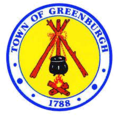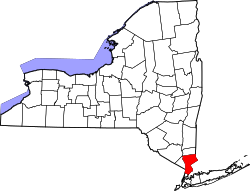Geography
Greenburgh is bordered by the city of Yonkers on the south, the town of Mount Pleasant to the north, and to the east by the city of White Plains and the town of Scarsdale. [7] The boundary between Greenburgh and Mount Pleasant is the boundary between the adjacent villages of Tarrytown (in Greenburgh) and Sleepy Hollow (in Mount Pleasant), which runs along Andre Brook. Greenburgh's western boundary is the Hudson River. [7] The Tappan Zee Bridge, whose eastern end is in Tarrytown, connects Greenburgh with South Nyack in Rockland County, New York. [8]
According to the United States Census Bureau, the town has a total area of 36.1 square miles (93.5 km2), of which 30.3 square miles (78.5 km2) is land and 5.8 square miles (15.0 km2), or 16.07%, is water. [9]
Demographics
Historical population| Census | Pop. | Note | %± |
|---|
| 1790 | 1,450 | | — |
|---|
| 1820 | 2,064 | | — |
|---|
| 1830 | 2,195 | | 6.3% |
|---|
| 1840 | 3,361 | | 53.1% |
|---|
| 1850 | 4,291 | | 27.7% |
|---|
| 1860 | 8,929 | | 108.1% |
|---|
| 1870 | 10,790 | | 20.8% |
|---|
| 1880 | 8,934 | | −17.2% |
|---|
| 1890 | 11,613 | | 30.0% |
|---|
| 1900 | 15,564 | | 34.0% |
|---|
| 1910 | 21,148 | | 35.9% |
|---|
| 1920 | 23,881 | | 12.9% |
|---|
| 1930 | 35,821 | | 50.0% |
|---|
| 1940 | 40,145 | | 12.1% |
|---|
| 1950 | 47,527 | | 18.4% |
|---|
| 1960 | 76,213 | | 60.4% |
|---|
| 1970 | 85,827 | | 12.6% |
|---|
| 1980 | 82,881 | | −3.4% |
|---|
| 1990 | 83,816 | | 1.1% |
|---|
| 2000 | 86,764 | | 3.5% |
|---|
| 2010 | 88,400 | | 1.9% |
|---|
| 2020 | 95,397 | | 7.9% |
|---|
|
As of the 2000 census, [11] there were 86,764 people, 33,043 households, and 23,097 families residing in the town. The population density was 2,842.7 inhabitants per square mile (1,097.6/km2). There were 34,084 housing units at an average density of 1,116.7 per square mile (431.2/km2). The racial makeup of the town was 72.41% White, 13.07% African American, 0.17% Native American, 8.77% Asian, 0.05% Pacific Islander, 2.94% from other races, and 2.59% from two or more races. Hispanic or Latino of any race were 9.02% of the population.
There were 33,043 households, out of which 32.4% had children under the age of 18 living with them, 57.3% were married couples living together, 9.8% had a female householder with no husband present, and 30.1% were non-families. 25.5% of all households were made up of individuals, and 9.1% had someone living alone who was 65 years of age or older. The average household size was 2.57 and the average family size was 3.10.
In the town, the population was spread out, with 23.7% under the age of 18, 5.9% from 18 to 24, 29.7% from 25 to 44, 26.2% from 45 to 64, and 14.6% who were 65 years of age or older. The median age was 40 years. For every 100 females, there were 90.3 males. For every 100 females age 18 and over, there were 84.5 males.
According to a 2007 estimate, the median income for a household in the town was $100,656, and the median income for a family was $118,360. [12] Males had a median income of $64,186 versus $46,658 for females. The per capita income for the town was $43,778. About 2.0% of families and 3.9% of the population were below the poverty line, including 3.4% of those under age 18 and 4.8% of those age 65 or over.
By 1991, 5% of the community's population was of Asian origins. [13]
Transportation
Interstate 87 (the New York State Thruway), the Cross Westchester Expressway, the Saw Mill River Parkway, the Bronx River Parkway, and the Sprain Brook Parkway all pass through the town. US routes include U.S. Route 9. State routes that traverse the town are Route 9A, Route 100 (as well as A, B and C) and Route 119.
The Metro-North Railroad's Hudson Line passes through the west of the town with stations at Hastings-on-Hudson, Dobbs Ferry, Ardsley-on-Hudson, Irvington and Tarrytown, and its Harlem Line passes through the east of the town with a station at Hartsdale.
Westchester County's Bee-Line Bus System also serves the town, and the HudsonLink Bus Service provides connections across the Governor Mario M. Cuomo Bridge to Rockland County.
This page is based on this
Wikipedia article Text is available under the
CC BY-SA 4.0 license; additional terms may apply.
Images, videos and audio are available under their respective licenses.





